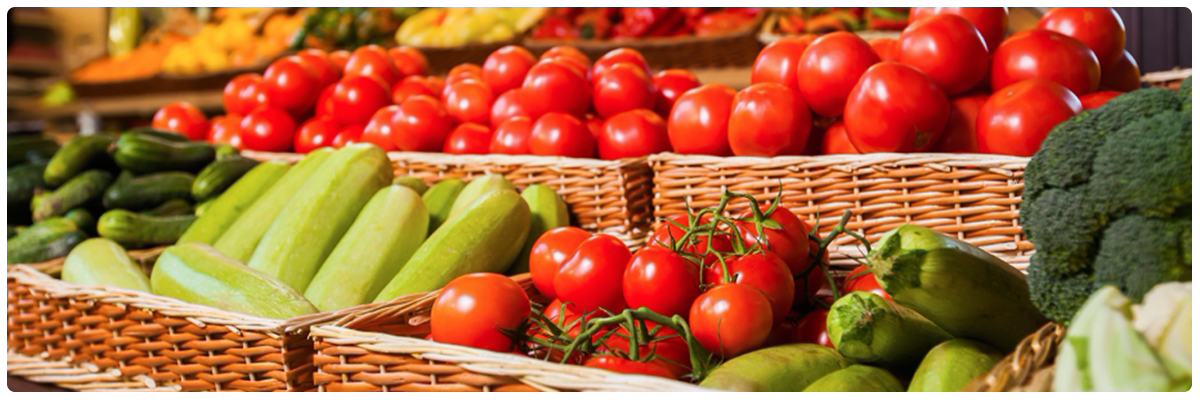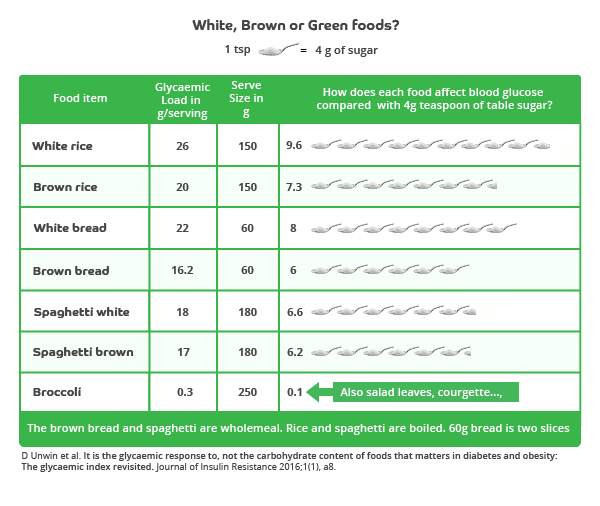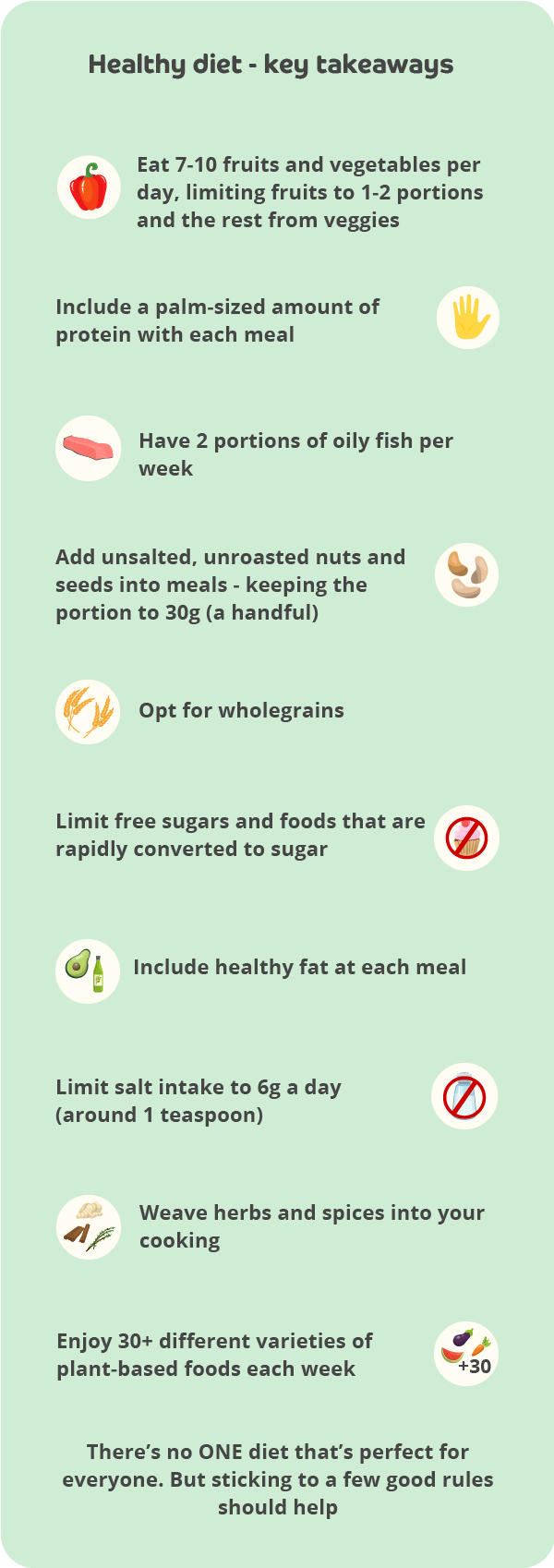Eating well is one of the best things we can do to keep ourselves healthy. Our diet not only impacts our health but also our energy levels and capacity to enjoy life.
In this article, we’ll help you understand the Nutrition Check found in the Evergreen Life app, so you can decide where you need to focus in order to improve your score. Whilst there are many differing opinions about what a healthy diet looks like, we offer some practical tips in areas where experts broadly agree, with links to a lot more information if you want to explore further.
What does a healthy diet look like?
For many of us, food is one of the great joys of life, but as well as the taste, we need to remember why we must eat – it’s for the nutrients, vitamins, minerals and trace elements that our bodies need to function. Briefly that’s:
Macronutrients: The three macronutrients are protein, carbohydrate and fat. Carbohydrates and fat are used to provide energy, whereas you can think of proteins as the building blocks of the body. ‘Macro’ means large, so these nutrients are required in relatively large amounts on a daily basis. You can learn more about macronutrients here.
Micronutrients: These are nutrients that the body needs in micro or small amounts. This class of nutrients includes minerals, vitamins and phytochemicals; these are chemicals found in plants that have health benefits. Most micronutrients are “essential” which means our body cannot manufacture them and we must obtain them through diet. Some like phytochemicals are not known to be essential but can have a positive impact on our health.
So where do you find these key nutrients? Our food tips, outlined below, will help you understand a bit more about where to find the key elements that should be in a healthy diet.
These tips aren’t intended for people following specific diets based on medical advice, religious teachings or personal preference. They’re also not intended for those with particular needs such as pregnant women.
1. Eat at least seven-ten portions of different coloured fruit and vegetables every day

Most of us know the age-old advice encouraging us to get our five a day – that is five portions of fruit and veg. But do you know why? The studies make compelling reading. A low intake of fruit and vegetables has been associated not just with an increased risk of cancer and cardiovascular mortality but a higher risk of death from all causes. A 2017 analysis of 95 studies found that eating ten or more (800g) different fruit and vegetables daily would be even better for us. The leading professional body for Registered Nutritional Therapy Practitioners, the British Association for Nutrition and Lifestyle Medicine (BANT) currently sit in the middle, recommending we enjoy at least seven fruit and veg a day, specifying limiting fruit to one or two portions per day, and the rest of your intake from the nutritional powerhouses that are veggies.
Fruit and vegetables are good sources of fibre and contain many important vitamins and minerals. Different colours of fruits and vegetables are associated with different phytochemicals. These compounds also give them their bright colours and distinctive taste. A growing body of research suggests that phytochemicals may have a wide range of health benefits in humans, including antioxidant and anti-inflammatory benefits. Some phytochemicals are well known, such as beta carotene in carrots and lycopene in tomatoes, but there are many more that may have a positive effect on our health. For instance, did you know that a combination of the two phytochemicals lutein and zeaxanthin was, as one study found, associated with a reduced risk of all-cause dementia in those aged 65 and over?
Fruit and vegetables can be grouped into six colours:

It can be easy to slip into the habit of eating the same fruit and vegetables week in week out. However, eating widely from all six colours every day helps to ensure maximum benefit from the fibre, vitamins, minerals and phytochemicals that colourful fruit and vegetables can provide. A variety can also result in better gut health, increasing your microbial diversity and beneficial Short-Chain Fatty Acid (SCFA)-producing bacteria.
If you struggle to increase the variety of your intake, here are a few ideas to get you going:
- Pick out at least one new vegetable each week when you go shopping.
- Swap the supermarket for a fruit and veg shop where you often get more variety.
- Try a veg box delivery which tend to follow the seasons and can be full of surprises!
2. Meat and plant sources of proteins

Protein is essential for the growth and repair of the body. It’s also important as part of a balanced meal to support blood sugar regulation as it helps to slow down the rate at which glucose is released. A good rule of thumb is to include a palm sized amount of protein with each meal.
Good animal sources of protein include eggs, poultry, dairy products and fish. BANT recommends making fish, poultry and eggs your main sources of protein, and eating lean red meat, bacon and other processed meats only occasionally. They advise eating pulses (lentils, beans, chickpeas) and nuts and seeds as vegetable protein, and limiting dairy. It’s worth being mindful that diets high in processed meats have been associated with an increased risk of cardiovascular disease and cancer.
Plant sources of protein mainly come from legumes (beans, lentils, split peas, chickpeas), grains, nuts, seeds and soy products with a smaller amount from vegetables. Individual plant foods tend to provide some, but not all, essential amino acids (building blocks of proteins). The exceptions are amaranth, buckwheat, quinoa, hemp, chia and soybeans which are complete sources of protein. Plant sources of protein tend to be high in gut-friendly fibre.
Research shows that a high plant protein intake is associated with lower risk of cardiovascular mortality and all cause mortality. Switching some animal protein for plant protein isn’t only good for the planet, but also kind to your wallet.
3. Support your brain with omega-3-rich oily fish

Current NHS advice is that a healthy diet should contain at least two portions of fish a week including at least one portion of oily fish. Oily fish like trout, salmon, mackerel, anchovies, herring and sardines are rich in omega-3 fatty acids and may help prevent heart disease.
As well as containing omega-3 fatty acids, oily fish is a source of essential protein, B vitamins and fat soluble vitamins A, D and E. It, along with seafood, such as prawns, mussels, scallops and squid, are also good sources of selenium, zinc, iodine and copper. Iodine is essential for thyroid hormones as is the trace mineral selenium for supporting the conversion of your main thyroid hormone (T4) to the active thyroid hormone (T3).
The type of fish we buy matters. Due to polluted oceans, rivers and seas, many fish contain elevated levels of toxic compounds such as mercury. Pregnant women need to take special care. Generally, the larger the fish the higher the level of mercury it’s likely to contain. Limiting tuna consumption and focusing on smaller fish will help reduce exposure to mercury.
If you’re a vegetarian or vegan or fancy a more sustainable option, tucking into algae / seaweed as an alternative may give you your fill of omega-3 fatty acids. If opting for a supplement, such as algae oil, it’s important to do your research as not all products are equal and will contain varying amounts of the omega-3 fatty acids DHA (Docosahexaenoic acid) and EPA (Eicosapentaenoic acid).
4. Nuts and seeds

Unsalted, unroasted nuts and seeds are nutrient dense foods containing vitamins, minerals, protein, fibre and healthy monounsaturated (MUFA) and polyunsaturated (PUFA) fatty acids. You may be surprised to learn that studies show that regular nut consumption doesn’t lead to weight gain, perhaps due to their positive impact on how full you feel.
Diets containing nuts, particularly walnuts, have consistently shown health benefits, particularly against heart disease. Almonds and pistachios have been found to help with glycaemic control.
Most of the antioxidants are found in the outer skin of the nut so choose nuts in their natural state. Try adding a sprinkle of chopped nuts or seeds to a salad or your morning porridge. A portion is a handful (about 30g).
5. Wholegrains

Wholegrains are rich in dietary fibre and micro-nutrients. The outer layer of the grain contains the bulk of the goodness, so consuming refined grains (white flour, bread or rice) means missing many of the benefits from the wholegrains. Commonly consumed wholegrain foods include wheat (spelt and durum), brown and long-grain rice, maize, oats, barley, rye, millet and sorghum.
People whose diets contain wholegrains have a lower risk of cardiovascular disease, cancer and Type 2 diabetes. Wholegrain intake seems to be protective against obesity with observational studies suggesting that those who consume three servings of wholegrains a day are more likely to have a lower BMI and carry less weight around their middle.
6. Avoid sugar
We’re advised to cut out or at least limit free sugars due to the negative impact it has on many areas of our health. Free sugar is the sugar that’s found in foods, such as cakes, sweets, biscuits, chocolate, soft drinks, breakfast cereal and yoghurts, plus any sugar you add to drinks and food. They’re also found naturally in honey, unsweetened fruit juice, vegetable juices and smoothies.
It’s also important to consider foods that the body treats as sugar. Many carbohydrate-containing foods, such as bread and pasta, are rapidly converted to sugar when we eat them. The table below, based on data from Dr David Unwin and phcuk.org, shows the teaspoons of sugar equivalent in various foods. One teaspoon of sugar is about 4g. If you want to lose weight, or just to support your health, try to be aware of these hidden sugars. Such commonly concealed sugars tend to be found in low fat products like yoghurt as they disguise the often-unsavoury taste that’s brought about by stripping out the fat. Sometimes foods that we perceive as “healthy” due to their “low fat” label are the opposite, so always check the label.
Table: The amount of sugar in white, brown and green foods.

Food for thought
Processed food and drink
The consumption of ultra-processed foods is on the rise all over the world. A recent analysis showed that the UK had the third highest volume sales of ultra-processed foods per capita when compared to 80 high and middle income countries. Examples include: sweet, fatty or salty snack products, some breakfast cereals, some types of ice cream, sugar sweetened drinks, confectionery, margarine, French fries, burgers, hot dogs, fish and chicken nuggets.
Ultra-processed foods are cheap sources of energy. They’re made using a series of industrial processes which are very different to how we might cook at home. Typically they have a high glycaemic load and higher consumption is associated with weight gain and several other diet-related chronic diseases.
So why do we eat them? Ultra-processed products are designed to be extremely tasty and attractive to the consumer. Often these products are our most convenient option. The problem is that, by filling ourselves up with these empty calories, we’re displacing health promoting and nutrient-dense real food from our diet. A high consumption of ultra-processed food has been associated with a wide range of poor health outcomes and so focusing on real food wherever possible is recommended.
Fats

BANT highlights our need for good quality fats to absorb vitamins A, D, E and K and to produce essential fatty acids, which our bodies can’t make themselves. They call for us to regularly eat healthy unsaturated fats, such as avocados, olives, nuts and seeds (known as monounsaturated fats), and oily fish, extra virgin olive oil and flaxseeds (known as polyunsaturated fats). This is because unsaturated fats are an important component of a healthy balanced diet.
The fat contained naturally in many foods is a mixture of saturated and unsaturated fat. As a general rule, saturated fat is solid at room temperature while unsaturated is generally liquid. It used to be thought that eating saturated fat would increase your risk of heart disease. Recent studies show no benefit to cardiovascular disease risk or total mortality risk from reducing saturated fats. Whilst there’s not yet universal agreement on saturated fats, healthy non-trans saturated fats that are naturally occurring are a useful part of a balanced diet. Many foods, including extra virgin olive oil, are a mix of different types of fats (including saturated).
Industrial trans fats are found in fried, processed and commercially baked foods where they help to prolong the shelf life of products. They’re sometimes labelled “partially hydrogenated vegetable oil.” Research shows that trans fats have no benefit for human health, in fact, excessive dietary trans fats are a significant risk factor for cardiovascular events, cancer and diabetes.
The guidance on fat intake is currently under debate as an increasing number of experts are now arguing that there’s little evidence healthy non-trans saturated natural fats are the cause of obesity and poor health. Indeed, there’s a growing body of evidence to show the benefits of extra virgin olive oil and nuts on cholesterol and cardiovascular risk.
Which oil is best for health?
Watch out for oils that have been refined, as opposed to healthier cold pressed oils, which have not been exposed to heat or chemical solvents. Always check the label carefully and avoid any oils that are labelled “refined”. Even a healthy oil like olive oil can be refined, therefore removing many of the health promoting compounds it contains. How do you spot a refined oil? Most bottles labelled “vegetable oil” are refined and you’re more likely to find refined oil in a plastic not a glass bottle. Look for oil labelled “cold pressed” or “extra virgin” in the case of olive oil.
Seed oils are higher in omega-6, which is mostly pro-proinflammatory. The body needs some omega-6 for mounting an effective immune system response to infection and injury and it may protect some against some chronic diseases.
Ratios of higher omega-3 to omega-6 are often recommended and remain debatable, but what’s clear is that we should focus on a diet rich in omega-3, with a little omega-6, and it should come from whole foods sources or cold-pressed unrefined oils like extra virgin olive oil.
Salt

Too much salt can lead to high blood pressure, which puts a strain on our heart and blood vessels, and that’s why official guidance is that salt intake should be limited to 6g a day, that’s around one teaspoon. It’s important not to add too much salt to your food, but also to be aware of foods which have high salt content, such as processed meats, salted nuts, cheese and many convenience foods, including ready meals. This is one of the advantages of cooking from scratch, you’re in control of the ingredients!
When home-cooking, consider sprinkling spices like paprika, black pepper and garlic in your dishes for seasoning in place of salt. If you do decide to go with salt in your meals, why not opt for pink Himalayan or sea salt? The beneficial minerals and trace elements like iron they contain make them healthier than table salt, which is made up of nearly all sodium chloride. Too much sodium chloride increases our blood pressure. Good quality sea salt adds great flavour but with considerably less sodium, maybe up to 30% less, than table salt, so could be worth a try. Seasoned salt with extra herbs and spices also spruces up a dish and adds other beneficial nutrients as a bonus.
Extra boosts

Adding herbs and spices not only enhances the flavour but can also offer health benefits through their high antioxidant activity. Don’t forget though, salt isn’t a spice.
Your microbiome

Trillions of microorganisms live in our intestinal tract and help us digest food and absorb nutrients. This is our gut microbiome and it’s unique to each one of us, so even the best dietary advice might not be right for you personally. It’s predicted that microbiome testing could become an important strand of personalising nutrition and even managing health conditions in the future.
We know that our gut microbiome thrives on the fibre in plants. Research from The American Gut Project found that “the number of unique plant species that a subject consumes is associated with microbial diversity” with a particular benefit seen in those consuming 30+ different varieties of plant-based foods a week. Lower bacterial diversity has been seen in people with a variety of different conditions such as, Inflammatory Bowel Disease, psoriatic arthritis, Type 1 and 2 diabetes, atopic eczema, coeliac disease, obesity and arterial stiffness. Taking care of your gut microbiome will help it to look after you.
The bottom line
There’s no ONE diet that’s perfect for everyone. The exact makeup of what counts as healthy and balanced nutrition will vary based on your age, gender, genetics, physical activity, and most likely your gut microbiome. However, if you focus on eating a diverse colourful range of vegetables, fruits, legumes, wholegrains, herbs, spices, nuts and seeds with good quality protein (animal or plant) and make sure that you’re getting sufficient omega-3s, as outlined by BANT, then you’ll be on the right track.
A DNA test will help you gain a greater understanding of how your body processes a number of foods and whether you are prone to vitamin deficiencies.
You can order an Evergreen Life DNA test kit here.
Remember, small changes over time add up to big results in the long run so if you’re new to improving your diet, perhaps change one or two things and see how you feel. Retake the Nutrition Check in your Evergreen Life app once you’ve made the changes to see how your Wellness Score in your app is affected.

Always check with your GP about any concerns you may have about your diet.
Not got the app yet? With Evergreen Life, you can measure and track areas of your wellbeing like diet, sleep and happiness – and also get more personalised tips on how to improve. Download the app below and take the Nutrition Check to see how healthy your diet is.
Reviewed by:
Anna Keeble MA BA Wellbeing Expert
Dr Claire Marie Thomas MRCGP DFSRH DTMH DipNLP MBChB BMedSci Medical Expert
- Aune D, Giovannucci E, Boffetta P, et al. (2017) Fruit and vegetable intake and the risk of cardiovascular disease, total cancer and all-cause mortality – a systematic review and dose response meta-analysis of prospective studies. International Journal of Epidemiology 46: 1029–1056 (doi: 10.1093/ije/dyw319).
- Benatar JR (2010) Trans fatty acids and coronary artery disease. Open Access Journal of Clinical Trials 2010: 9–13 (doi: 10.2147/OAJCT.S7091)
- Beydoun MA, Beydoun HA, Fanelli-Kuczmarski, et al. (2022) Association of Serum Antioxidant Vitamins and Carotenoids With Incident Alzheimer’s Disease and All-Cause Dementia Among US Adults. Neurology 98: e2150-e2162 (doi: 10.1212/WNL.0000000000200289).
- British Association for Nutrition and Lifestyle Medicine (BANT) (2022) The Wellness Solution. British Association for Nutrition and Lifestyle Medicine (BANT).
- British Association for Nutrition and Lifestyle Medicine (BANT) (2022) Dietary fats: are they healthy or harmful? British Association for Nutrition and Lifestyle Medicine (BANT).
- De Souza RG, Mente A, Maroleanu A, et al. (2015) Intake of saturated and trans unsaturated fatty acids and risk of all cause mortality, cardiovascular disease, and type 2 diabetes: systematic review and meta-analysis of observational studies. BMJ 351: h3978 (doi: 10.1136/bmj.h3978).
- De Souza RGM, Schincaglia RM, Pimental GD, et al. (2017) Nuts and Human Health Outcomes: A Systematic Review. Nutrients 9: 1311 (doi: 10.3390/nu9121311).
- Drake SL and Drake MA (2010) Comparison of salty taste and time intensity of sea and and salts from around the world. Journal of Sensory Studies 26: 25-34 (doi: 10.1111/j.1745-459X.2010.00317.x).
- Elizabeth L, Machado P, Zinöcker M, et al. (2020) Ultra-Processed Foods and Health Outcomes: A Narrative Review. Nutrients 12: 1955 (doi: 10.3390/nu12071955).
- Food and Agriculture Organization of the United Nations (2008) Fats and fatty acids in human nutrition, Report of an expert consultation. Food and Agriculture Organization of the United Nations.
- Gabriel B (2019) Is Himalayan salt natural? The Salt Valley.
- Helmenstine A (2019) What Is Table Salt? ThoguhtCo.
- Iqbal R, Dehghan M, Mente A, et al. (2021) Associations of unprocessed and processed meat intake with mortality and cardiovascular disease in 21 countries [Prospective Urban Rural Epidemiology (PURE) Study]: a prospective cohort study. The American Journal of Clinical Nutrition 114: 1049–1058 (doi: 10.1093/ajcn/nqaa448).
- Islam A, Amin MN, Siqqiqui SA, et al. (2019) Trans fatty acids and lipid profile: A serious risk factor to cardiovascular disease, cancer and diabetes. Diabetes and Metabolic Syndrome: Clinical Research and Reviews 13: 1643-1647 (doi: 10.1016/j.dsx.2019.03.033).
- Jinadasa BKKK, Jayasinghe GDTM, Pohl P, et al. (2021) Mitigating the impact of mercury contaminants in fish and other seafood—A review. Marine Pollution Bulletin 112710 (doi: 10.1016/j.marpolbul.2021.112710).
- Karl JP and Saltzman E (2012) The Role of Whole Grains in Body Weight Regulation. Adv Nutr. 3: 697-707 (doi: 10.3945/an.112.002782).
- Khan SU, Lone AN, Kahn MS, et al. (2021) Effect of omega-3 fatty acids on cardiovascular outcomes: A systematic review and meta-analysis. eClinicalMedicine Part of THE LANCET Discovery Science 38: 100997 (doi: 10.1016/j.eclinm.2021.100997).
- Kosti RI, Kasdagli MI, Kyrozis A, et al. (2022) Fish intake, n-3 fatty acid body status, and risk of cognitive decline: a systematic review and a dose-response meta-analysis of observational and experimental studies. Nutrition Reviews 80: 1445–1458 (doi: 10.1093/nutrit/nuab078).
- Liu AG, Ford NA, Hu FB, et al. (2017) A healthy approach to dietary fats: understanding the science and taking action to reduce consumer confusion. Nutritional Journal 16 (doi: 10.1186/s12937-017-0271-4).
- Marklund M, Wu JHY, Imamura F, et al. (2019). Biomarkers of Dietary Omega-6 Fatty Acids and Incident Cardiovascular Disease and Mortality. Circulation 139: 2422-2436. (doi: 10.1161/CIRCULATIONAHA.118.038908).
- McCallum L, Lip S and Padmanabhan S (2015) The hidden hand of chloride in hypertension. Pflugers Arch. 467: 595-603 (doi: 10.1007/s00424-015-1690-8).
- Moghaddam E, Vogt JA and Wolever TMS (2006) The Effects of Fat and Protein on Glycemic Responses in Nondiabetic Humans Vary with Waist Circumference, Fasting Plasma Insulin, and Dietary Fiber Intake. The Journal of Nutrition 136: 2506–2511 (doi: 10.1093/jn/136.10.2506).
- Monjotin N, Amiot MJ, Fleurentin J, et al. (2022) Clinical Evidence of the Benefits of Phytonutrients in Human Healthcare. Nutrients 14: 1712 (doi: 10.3390/nu14091712).
- Monteiro CA, Canoon G, Moubarac J-C, et al. (2017) The UN Decade of Nutrition, the NOVA food classification and the trouble with ultra-processing. Public Health Nutrition. 21: 5-17. (doi: 10.1017/S1368980017000234).
- Oyebode O, Gordon-Dseagu V, Walker A, et al. (2014) Fruit and vegetable consumption and all-cause cancer and CVD mortality: analysis of Health Survey for England data. J Epidemiol Community Health 68: 856–862. (doi: 10.1136/jech-2013-203500).
- Power R, Prado-Cabrero A, Mulcahy R, et al. (2019) The Role of Nutrition for the Aging Population: Implications for Cognition and Alzheimer’s Disease. Annual Review of Food Science and Technology 10: 619–39 (doi: 10.1146/annurev-food-030216-030125).
- Rauber F, Steele EM, Louzada MLdC, et al. (2020) Ultra-processed food consumption and indicators of obesity in the United Kingdom population (2008-2016). PLoS ONE 15: e0232676 (doi: 10.1371/journal.pone.0232676).
- Rohrmann S, Overvad K, Bueno-de-Mesquita HB, et al. (2013) Meat consumption and mortality – results from the European Prospective Investigation into Cancer and Nutrition. BMC Medicine 11: 63 (doi: 10.1186/1741-7015-11-63).
- Saini RK, PP, Screed RV, et al. (2021) Omega-3 Polyunsaturated Fatty Acids (PUFAs) Emerging Plant and Microbial Sources, Oxidative Stability, Bioavailability, and Health Benefits- A Review. Antioxidants 10: 1627 (doi: 10.3390/antiox10101627).
- ScienceDirect (n.d.) Linoleic Acid. ScienceDirect.
- Shreenath AP, Ameer MA and Dooley J (2022) Selenium Deficiency. StatPearls [Internet]. Treasure Island (FL): StatPearls Publishing (PMID: 29489289).
- Slavin, J (2004). Whole grains and human health. Nutrition Research Reviews 1: 99 – 110 (doi: 10.1079/NRR200374).
- Unwin D, et al. (2016) White, brown or green foods? Journal of Insulin Resistance 1: a8.
- Valdes AM, Walter J, Segal E, et al. (2018) Role of the gut microbiota in nutrition and health. BMJ. 361: k2179. (doi: 10.1136/bmj.k2179).
- Valk R, Hammill J and Grip J (2022) Saturated fat: villain and boogeyman in the development of cardiovascular disease? European Journal of Preventive Cardiology 29: 2312–2321 (doi: 10.1093/eurjpc/zwac194).
- Yashin A, Yashin Y, Xia X, et al. (2017) Antioxidant Activity of Spices and Their Impact on Human Health: A Review. Antioxidants 6: 70 (doi: 10.3390/antiox6030070).
- Youness RA, Dawoud A, EITahawy O, et al. (2022) Fat-soluble vitamins: updated review of their role and orchestration in human nutrition throughout life cycle with sex differences. Nutrition & Metabolism 19: 60 (doi: 10.1186/s12986-022-00696-y).
- Zhu F, Du B, Xu B (2017) Anti-inflammatory effects of phytochemicals from fruits, vegetables, and food legumes: A review. Critical Reviews in Food Science and Nutrition 58: 1260-1270 (doi: 10.1080/10408398.2016.1251390).
- Zhu Y, Bo Y and Liu Y (2019) Dietary total fat, fatty acids intake, and risk of cardiovascular disease: a dose-response meta-analysis of cohort studies. Lipids in Health and Disease 18: 91 (doi: 10.1186/s12944-019-1035-2).
- Zong G, Liu G, Willett WC, et al. (2019) Associations Between Linoleic Acid Intake and Incident Type 2 Diabetes Among U.S. Men and Women. Diabetes Care 42: 1406–1413 (doi: 10.2337/dc19-0412).








